Getting Started
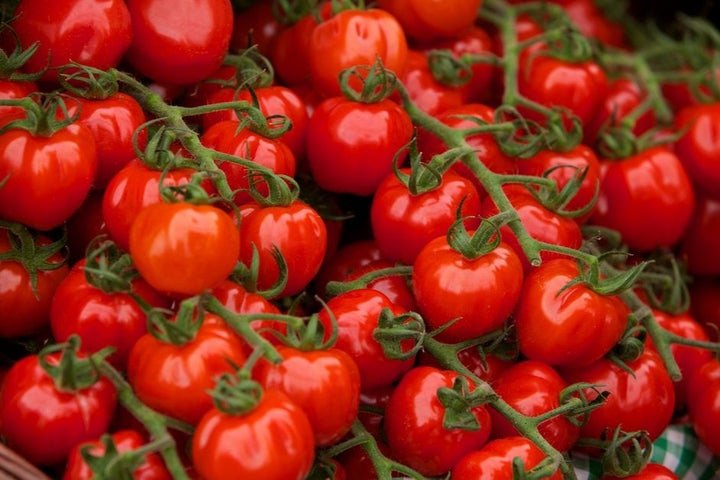
Tomatoes are one of the most popular crops to grow – they can be started from seed indoors or bought as young plants, then grown either outdoors or in a greenhouse, in pots or in the ground. They grow particularly well in a greenhouse, usually producing an earlier and larger crop. When grown outdoors, these tender plants need a warm, sunny, sheltered site. Botanically known as Solanum lycopersicum, tomatoes are closely related to potatoes, and are similarly susceptible to blight disease outdoors, but rarely in a greenhouse.
Tomatoes do need some attention to grow well, including protection from frost and a steady supply of moisture. But they’re well worth the effort when you can eat your own home-grown tomatoes all summer long, freshly picked, warmed by the sun, and at their sweetest, juiciest best.
There’s an enormous range of varieties to choose from, which is another great benefit of growing your own. There are fruits of different sizes, colours, textures and flavours, to suit all tastes – far more choice than you get in the supermarket. There are plants of various sizes too, for different growing locations and amounts of space, from tall and vigorous varieties to more compact bush types, as well as dwarf varieties for small containers and even trailing plants for hanging baskets. Small-fruited varieties tend to be the easiest to grow, fastest to fruit and most prolific, but it’s well worth experimenting with all the different types.
Month by Month
Sow
Plant
Harvest
Choosing What To Grow
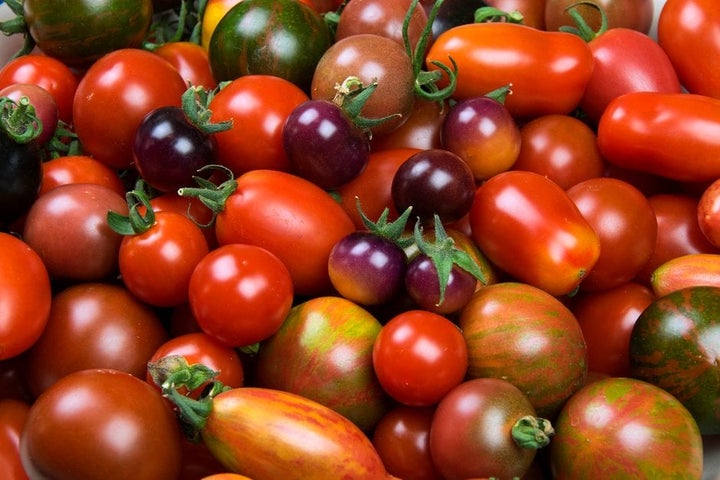
Tomatoes generally have two different ways of growing:
- (or indeterminate) tomatoes are vigorous, fast-growing plants that get very tall and need suitably tall supports, both in a greenhouse and outdoors. As they grow vertically, they take up very little ground space, but do need regularly tying-in to supports and the removal of side shoots to grow and crop well
- Bush (or determinate) tomatoes are naturally more compact plants, great for smaller spaces. Trailing types can even be grown in windowboxes and hanging baskets, with the stems cascading over the sides. These are the easiest type to grow and need little maintenance, though the stems may need support when heavily laden with fruit
Check seed packets or plant labels before buying, to ensure you get the type to suit your growing space.
There are lots of tomato varieties to choose from, offering fruits of various sizes, shapes, flavours and levels of sweetness. Fruit colours range from traditional red to dark purple, pink, orange, yellow or green, and even striped. There are heirloom varieties, grown for many generations, as well as modern, disease-resistant choices. There are small round cherry fruits, elongated plum varieties, uniform, medium-sized salad tomatoes and huge, wrinkled, mis-shapen beefsteaks, all full of flavour and with their own individual characteristics.
For varieties that will reliably produce good crops, look for those with an RHS Award of Garden Merit (AGM) – see our list of AGM fruit and veg (135kB pdf) and our Recommended Varieties below. You’ll also find tomatoes growing in the veg gardens and greenhouses in all the RHS gardens over the summer months, so do visit to compare varieties and pick up growing tips.
What and where to buy
Tomato seeds are widely available from garden centres and other seed stockists. Many also sell young plants in spring and early summer. These are ideal if you don’t have the time or space to grow from seed, but the choice of varieties is limited.
Grafted plants are a recent introduction – these are generally more vigorous than seed-grown plants, providing earlier and larger crops, and greater resistance to disease. However, they are more expensive and the choice of varieties is currently fairly small. Grafted plants are mainly available from online suppliers.
Recommended Varieties

'Cristal' AGM
Salad – early, reliable crops of tasty fruits. Disease resistant. Cordon type.

'Tigerella' AGM
Salad – tasty red fruits with orange stripes. For greenhouse or outdoors. Cordon type.

'Sungold' AGM
Cherry – golden-orange fruits with a sweet tangy flavour. Crops over a long period. Cordon type.
Sowing
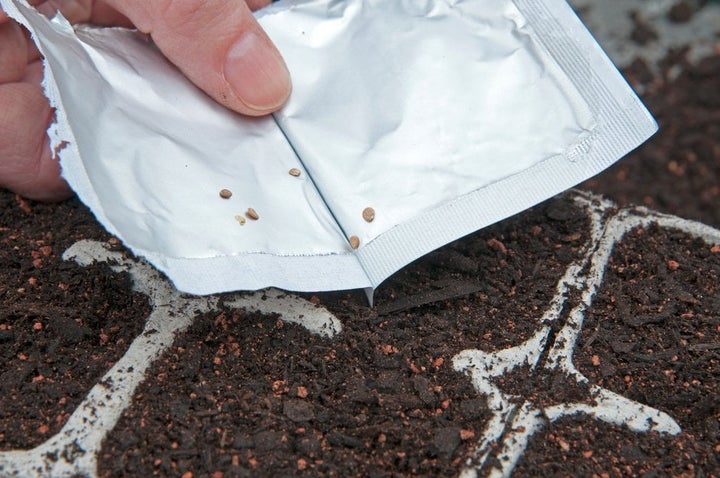
Tomatoes are easy to grow from seed indoors. Sow from late February to mid-March if you’ll be growing your crop in a greenhouse, or from late March to early April if they’ll be outside. Seeds need a temperature of about 18°C (64°F) to germinate, so use a or place on a warm windowsill and cover with a clear plastic bag to maintain . As soon as appear – usually within a fortnight – uncover and place in as much light as possible, to prevent them growing thin and leggy.
Pricking out and potting on
After a couple of weeks, once seedlings have a couple of true leaves, move them into individual pots or of peat-free multi-purpose . Lift each seedling individually, using a to support its , and hold it by a leaf rather than the delicate stem. If the seedling is leggy, replant it more deeply, so the first pair of leaves is just above the compost surface. Keep in a bright location, with a temperature of at least 16°C (60°F), and water regularly. After about a month, they should be ready to plant in their final position.
Planting
Young, well-rooted tomato plants, either grown from seed or recently bought, can be planted into their final position in early summer, once temperatures are reliably above 16°C (60°F). You can plant them in large containers or growing bags in a greenhouse or outdoors, or plant them in the ground. To grow outdoors, choose a really warm, sunny, sheltered location.
Plant tomatoes deeply, so the first set of leaves is just above the soil surface – the buried section of stem will then produce additional roots. Tomatoes are tender, so before planting out, acclimatise them to garden conditions by hardening off.
Planting in containers
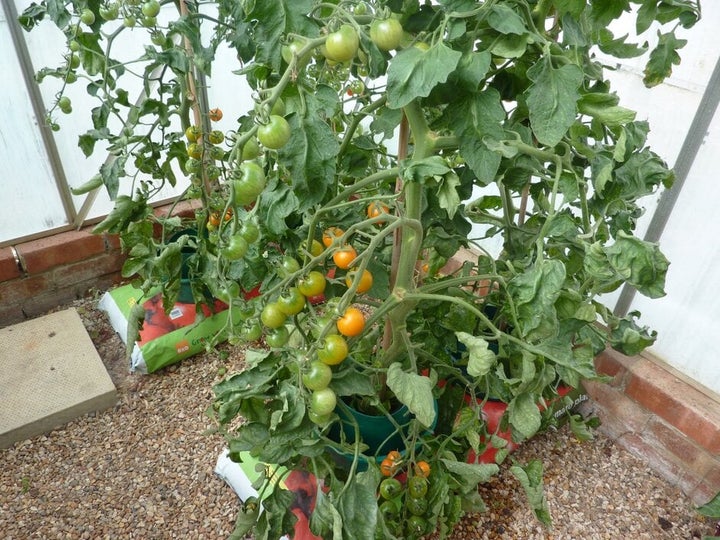
Tomatoes do well in large containers and growing bags in a greenhouse or outdoors in full sun, and are very productive in a small space. Use peat-free loam-based or multi-purpose . Plant one tomato plant in a 30–45cm (12–18in) pot and two in a standard growing bag.
- Bush types are compact and ideal for large patio containers, troughs, windowboxes and even hanging baskets
- types grow well in large containers, with a tall for support. This can make the pots top-heavy, so position in a sheltered site, ideally against a sunny wall. In a greenhouse, you can use canes or vertical strings for support – tie the stings to the roof, so they hang down vertically, and bury the other end under the when you plant. The string should be quite slack, so it can be wound round the top of the main stem as the plant grows. See Pruning and Training, below, for more tips
Planting in the ground
Tomatoes thrive in rich, free-draining but moisture-retentive soil, so add plenty of garden before planting. Alternatively, if you're practising no-dig, mulch the soil and plant directly into the . Choose your warmest, sunniest spot, sheltered from the wind. Space plants 45–60cm (18–24in) apart, depending on their eventual size – check seed packets for exact spacings. With tomatoes, insert a sturdy next to the plant and tie in the main stem loosely.
Avoid growing tomatoes in the same bed in consecutive years, to prevent the build-up of diseases in the soil. Alternatively, you can use a growing method called ring culture in a greenhouse border.
Plant Care
Watering
Water tomato plants regularly to keep the soil or evenly moist. Fluctuating moisture levels can cause problems with the fruit, such as splitting or blossom end rot (see Problems, below). Plants in containers dry out quickly, so may need watering daily in hot weather. Curling leaves can be a sign that a tomato plant is short of water.
Top tip
Sink a 15cm (6in) pot into the ground alongside tomato plants and water into it, so the water goes directly down to the roots. The moisture doesn’t then sit around the neck of the plants, which can lead to rotting.
Feeding
To boost fruiting of container plants, feed every 10–14 days with an organic high potassium liquid fertiliser once the first fruits start to swell. Tomatoes growing in enriched ground may not need additional feeding, but a fortnightly feed can help to increase yields.
Mulching
plants growing in the ground or in a greenhouse border to help retain moisture and deter weeds. Lay a thick layer of garden or well-rotted manure around plants, but leave a gap around the base of the stem, to prevent rotting.
Improving pollination
When growing tomatoes in a greenhouse, open the vents regularly to give pollinating insects access to the flowers. You can also lightly tap or shake the flowers when fully open to aid pollen transfer within the flower. Misting flowers with water can also help.
Pruning And Training
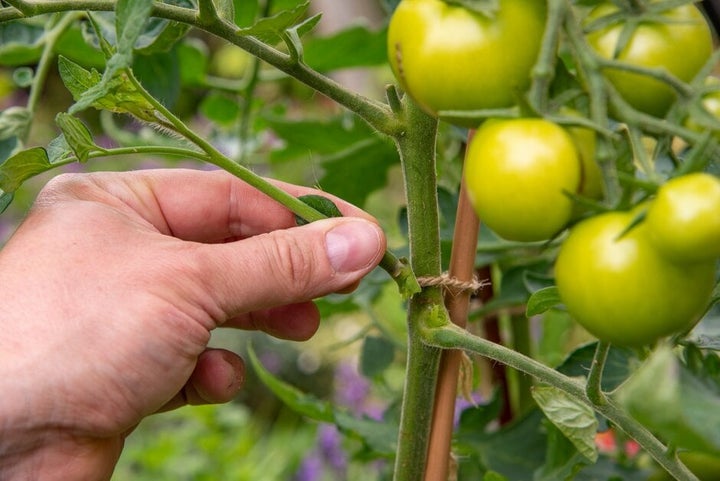
The two different types of tomatoes are trained differently – check your seed packet or plant label to see which type you are growing:
- tomatoes are grown as tall, single-stemmed plants – they need tall supports and the side-shoots should be removed regularly. This keeps these vigorous plants in check and ensures they put their energy into fruit production – see details below
- Bush tomatoes are more compact and their side-shoots should be left to grow. Plants may need support if they grow quite large. Also, if they carry a heavy crop of tomatoes, the side-shoots may start to droop or be at risk of snapping. If so, simply add short vertical canes when and where required, tying in the shoots loosely
Cordons: training up supports
Cordon tomatoes need support, usually either a tall sturdy or a vertical string coming down from an overhead horizontal support, such as a greenhouse roof, and anchored under the plant’s at planting time. However, tomatoes don’t cling to supports or wrap around them naturally, so must be attached by hand as they grow. If using a cane support, simply tie the main stem to it at regular intervals as it grows. If using a vertical string, gently wind the string around the top of the main stem as it grows.
When plants reach the top of their support or have set seven fruit indoors or four trusses outdoors, remove the growing point of the main stem at two leaves above the top .
Cordons: removing side-shoots
Cordon tomatoes are best grown as single-stemmed plants. However, these vigorous plants naturally produce side-shoots from the joints where leaves sprout from the main stem. These side-shoots should be removed to keep plants growing vertically on just one stem. If they’re not removed, the side-shoots grow rapidly, forming a mass of long, scrambling, leafy stems that are difficult to support, produce few fruits and take up a lot of space.
Removing the side-shoots is simple – each time you water, check the plant for any shoots sprouting just above each leaf, from the joint between the leaf and the main stem. Pinch these out or snap them off.
Watch our video guide on how to plant, train and care for your cordon tomatoes:
Harvesting
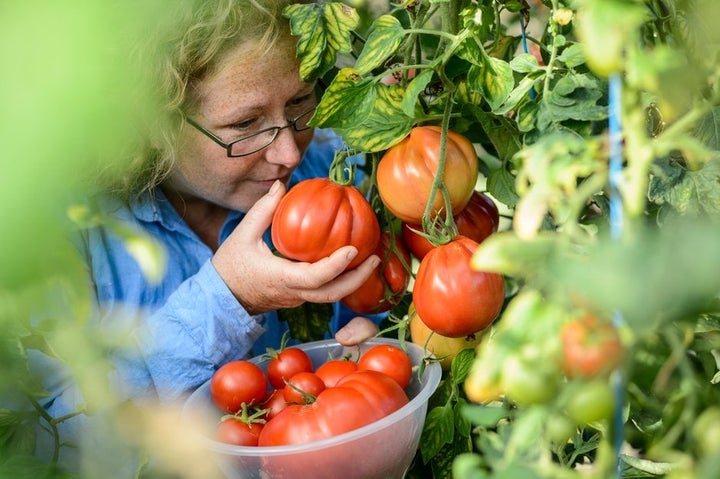
Tomatoes start to ripen from mid-summer onwards, although timing depends on the variety, weather conditions and fruit size. Smaller cherry tomatoes ripen more quickly than larger fruits, and greenhouse plants usually start cropping earlier than those outdoors, and continue for longer, well into autumn. Check plants every few days and pick tomatoes individually, with the stalk still attached, as soon as they’re ripe and fully coloured.
At the end of the growing season, lift outdoor plants with unripe fruit and either lay them on straw under cloches to ripen or pick the fruits and place somewhere warm and dark to ripen. Alternatively, put unripe tomatoes in a drawer with a banana, to aid ripening.
Problem Solving
In a warm summer, tomatoes are easy to grow and will fruit readily if given a steady supply of moisture. However, problems can occur when growing conditions aren’t ideal, and plants can also be affected by several diseases and eaten by -sucking insects – see Common problems below for more details.
You can also find out more about problems on tomatoes in our video guide below:
Common Problems

Tomato blight
Tomato blight is a disease that attacks the foliage and fruit of tomatoes, causing rotting. It is most common in warm, wet weather, and in some years...

Tomatoes: fruit ripening problems
Although easy to grow and very rewarding, tomatoes can suffer from a range of easily preventable problems at the time of ripening.

Tomatoes: fruit splitting and cracking
Although easy to grow, tomato fruits can suffer from splitting and cracking in late summer. This is difficult to prevent, as it is caused by fluctuati...















